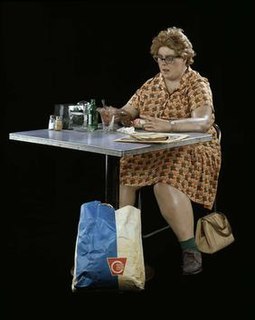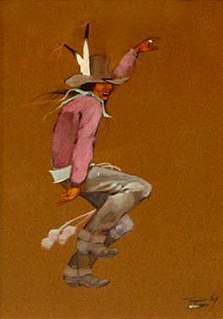
Emil Nolde was a German-Danish painter and printmaker. He was one of the first Expressionists, a member of Die Brücke, and was one of the first oil painting and watercolor painters of the early 20th century to explore color. He is known for his brushwork and expressive choice of colors. Golden yellows and deep reds appear frequently in his work, giving a luminous quality to otherwise somber tones. His watercolors include vivid, brooding storm-scapes and brilliant florals.

Andrew Newell Wyeth was an American visual artist, primarily a realist painter, working predominantly in a regionalist style. He was one of the best-known U.S. artists of the middle 20th century.

Newell Convers Wyeth, known as N. C. Wyeth, was an American artist and illustrator. He was the pupil of artist Howard Pyle and became one of America's greatest illustrators. During his lifetime, Wyeth created more than 3,000 paintings and illustrated 112 books — 25 of them for Scribner's, the Scribner Classics, which is the body of work for which he is best known. The first of these, Treasure Island, was one of his masterpieces and the proceeds paid for his studio. Wyeth was a realist painter at a time when the camera and photography began to compete with his craft. Sometimes seen as melodramatic, his illustrations were designed to be understood quickly. Wyeth, who was both a painter and an illustrator, understood the difference, and said in 1908, "Painting and illustration cannot be mixed—one cannot merge from one into the other."

Frank Earle Schoonover was an American illustrator who worked in Wilmington, Delaware. A member of the Brandywine School, he was a contributing illustrator to magazines and did more than 5,000 paintings.

James Browning Wyeth is a contemporary American realist painter, son of Andrew Wyeth, and grandson of N.C. Wyeth. He was raised in Chadds Ford Township, Pennsylvania, and is artistic heir to the Brandywine School tradition – painters who worked in the rural Brandywine River area of Delaware and Pennsylvania, portraying its people, animals, and landscape.

The Brandywine River Museum of Art is a museum of regional and American art located on U.S. Route 1 in Chadds Ford, Pennsylvania on the banks of the Brandywine Creek. The museum showcases the work of Andrew Wyeth, a major American realist painter, and his family: his father N.C. Wyeth, illustrator of many children's classics, his son Jamie Wyeth, a contemporary American realist painter, and his daughter Ann Wyeth McCoy, a composer and painter.

John Nicholas Ringling was an American entrepreneur who is the best known of the seven Ringling brothers, five of whom merged the Barnum & Bailey Circus with their own Ringling Bros World's Greatest Shows to create a virtual monopoly of traveling circuses and helped shape the modern circus. In addition to owning and managing many of the largest circuses in the United States, he was also a rancher, a real estate developer and art collector. He was inducted into the Florida Artists Hall of Fame in 1987.

The San Diego Museum of Art is a fine arts museum located at 1450 El Prado in Balboa Park in San Diego, California that houses a broad collection with particular strength in Spanish art. The San Diego Museum of Art opened as The Fine Arts Gallery of San Diego on February 28, 1926, and changed its name to the San Diego Museum of Art in 1978. The official Balboa Park website calls the San Diego Museum of Art "the region's oldest and largest art museum". Nearly half a million people visit the museum each year.

Hyperrealism is a genre of painting and sculpture resembling a high-resolution photograph. Hyperrealism is considered an advancement of Photorealism by the methods used to create the resulting paintings or sculptures. The term is primarily applied to an independent art movement and art style in the United States and Europe that has developed since the early 1970s. Carole Feuerman is the forerunner in the hyperrealism movement along with Duane Hanson and John De Andrea.

Gilcrease Museum, also known as the Thomas Gilcrease Institute of American History and Art, is a museum northwest of downtown Tulsa, Oklahoma housing the world's largest, most comprehensive collection of art of the American West, as well as a growing collection of art and artifacts from Central and South America. The museum is named for Thomas Gilcrease, an oil man and avid art collector, who began the collection. He deeded the collection, as well as the building and property, to the City of Tulsa in 1958. Since July 1, 2008, Gilcrease Museum has been managed by a public-private partnership of the City of Tulsa and the University of Tulsa. The Helmerich Center for American Research at Gilcrease Museum was added in 2014 at a cost of $14 million to provide a secure archival area where researchers can access any of the more than 100,000 books, documents, maps and unpublished materials that have been acquired by the museum.
Audrey Buller (1902–1984) was a Canadian artist who created hyperrealist oil paintings.

Edward Chalmers Leavitt (1842–1904), a native of Providence, Rhode Island, was an early New England painter said to be the most renowned still life painter of his day in Providence, although today he is largely forgotten.

Anton Otto Fischer was an illustrator for the Saturday Evening Post.
John Willard McCoy (1910–1989) was an American artist who painted landscapes, portraits, and still lifes. He was married to Ann Wyeth, daughter of N.C. Wyeth and sister of Andrew Wyeth, all artists.

Jerome Richard Tiger was a Muscogee Creek-Seminole painter from Oklahoma. Tiger produced hundreds of paintings from 1962 until his death in 1967.
Carolyn Wyeth, daughter of N.C. Wyeth and sister of Andrew Wyeth, was a well-known artist in her own right. Her hometown was Chadds Ford, Pennsylvania. She worked and taught out of N. C. Wyeth House and Studio. Her nephew, Jamie Wyeth was one of her students.
Raphaella Beatrice Spence is a British photorealist and hyperrealist painter.
Dennis Wojtkiewicz is an American Hyperrealist painter and draughtsman.

George Cope was an American painter.

Reception to Washington on April 21, 1789, at Trenton on his way to New York to Assume the Duties of the Presidency of the United States is a large-scale oil painting completed in 1930 by American artist N. C. Wyeth of president-elect George Washington at his reception in Trenton, New Jersey during his journey to the 1789 inauguration in New York City. The mural was commissioned by the First Mechanics National Bank of Trenton, now part of Wells Fargo. It has been on display in the lobby of Thomas Edison State University since 2013. Wells Fargo donated the painting to the university in 2019, the most expensive gift ever given to the university.














